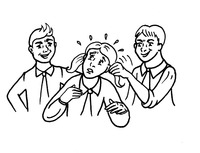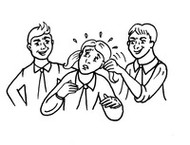7 Ways to Talk About Bullying with Your Child
21st Oct 2015
 Bullying can turn something as simple as a wait at a bus
stop or recess period into a nightmare for some kids. Bullying is widespread.
It’s happening in every school and community. Some say “kids will be kids,” but
it’s gotten a whole lot nastier than ever. It can leave emotional scars and
even involve threats of violence.
Bullying can turn something as simple as a wait at a bus
stop or recess period into a nightmare for some kids. Bullying is widespread.
It’s happening in every school and community. Some say “kids will be kids,” but
it’s gotten a whole lot nastier than ever. It can leave emotional scars and
even involve threats of violence.
It’s tough for parents when their children are being bullied. They want to barge in and put a stop to it, but that sort of response doesn’t teach anyone anything. Plus solving all your child’s problems can lead to even more bullying by his or her peers.
Bullying can happen a number of ways, through gossip, isolation, physical/emotional abuse, and of course, violence.
Here are some ways you can talk to your child about bullying.
1. Don’t be dismissive – It’s easy to laugh at a child’s problem and say “That’s no big deal,” but in their world it means a whole lot. If you dismiss their problems too often, you’ll find that they stop coming to you with them.
2. Identify safety issues first – You’d like to let your child resolve the situation himself, but if there’s a safety issue at play, you need to know right away. Report any violence or threats of violence.
3. Bring it up in a roundabout way – Many kids are reluctant to talk about bullying because they are embarrassed by the treatment. Find ways to bring it up without directly asking. For example, if you see someone treating someone else poorly on TV, ask your child, “Have you ever seen something like that?”
4. Offer lots of praise – When the topic is finally brought to the surface, make it very clear that your child did the right thing by bringing it to your attention. Encourage them to tell a teacher or someone at school who can quietly monitor the situation and intervene if necessary.
5. Encourage them not to respond – There’s no way to respond to a bully to diffuse the situation. They will be encouraged to continue their pursuit if any response is given. The best thing to do is separate oneself from the situation. The bully will fail to get what he wants and move on. Often this is easiest accomplished with the buddy system – stick with groups of friends whenever possible.
6. Help restore their confidence – A bully can quickly erode confidence, so encourage your child to spend lots of time with positive people, like their family and real friends
7. Provide a regular listening ear – Sometimes the best way out of the funk of being bullied is to just talk about it regularly. Once the topic is out in the air, often a child feels like they have shed the weight and won’t feel so intimidated by the bully.
Written by Alicia Overby - Founder & President of Baby Elephant Ears
Alicia is wife, mother, and creator of Baby Elephant Ears. Baby Elephant Ears was created out of parental concern, not financial desire. In 2005, when their second child was an infant, he cried all the time and just couldn't seem to get comfortable.
After seeking advice and suggestion from the medical community and alternative medicine, they eventually ended up in the chiropractors office where their baby was successfully treated for asubluxation, discomfort most likely the result of the strain during labor, which was now being exacerbated by the normal lack of infant neck strength. Only proper neck, head, and back alignment would offer him relief. When they couldn't find a product to give their baby the necessary support, Alicia took matters into her own hands and crafted her own infant support pillow. The first Baby Elephant Ears was born!
For more information, visit www.babyelephantears.com.
Interested in writing a guest blog for Baby Elephant Ears? Send your topic idea to pr@babyelephantears.com.
All data and information provided on this site is for informational purposes only. Baby Elephant Ears makes no representations as to accuracy, completeness, current-ness, suitability, or validity of any information on this site and will not be liable for any errors, omissions, or delays in this information, or any losses, injuries, or damages arising from its display or use. All information is provided on an as-is basis.


